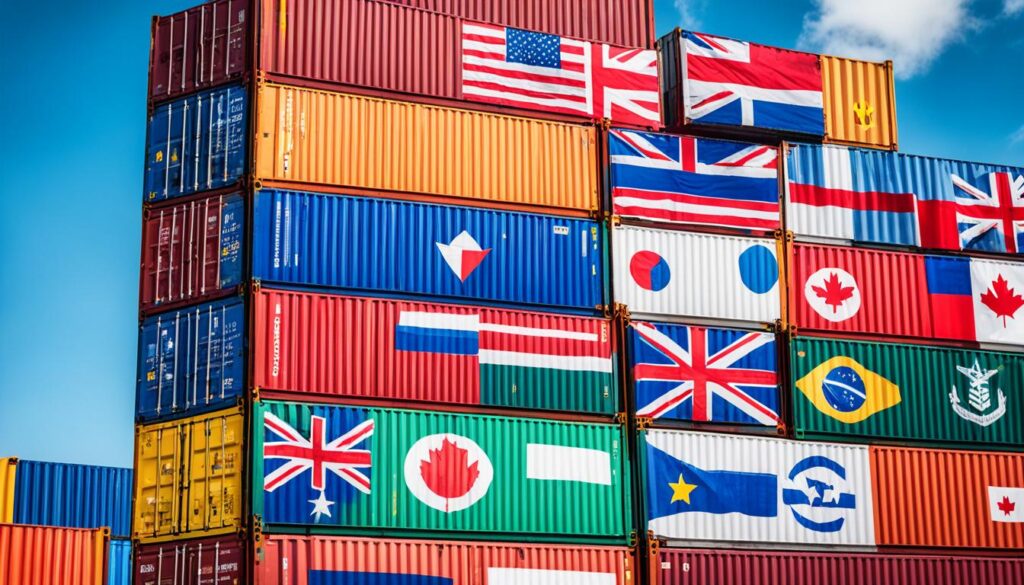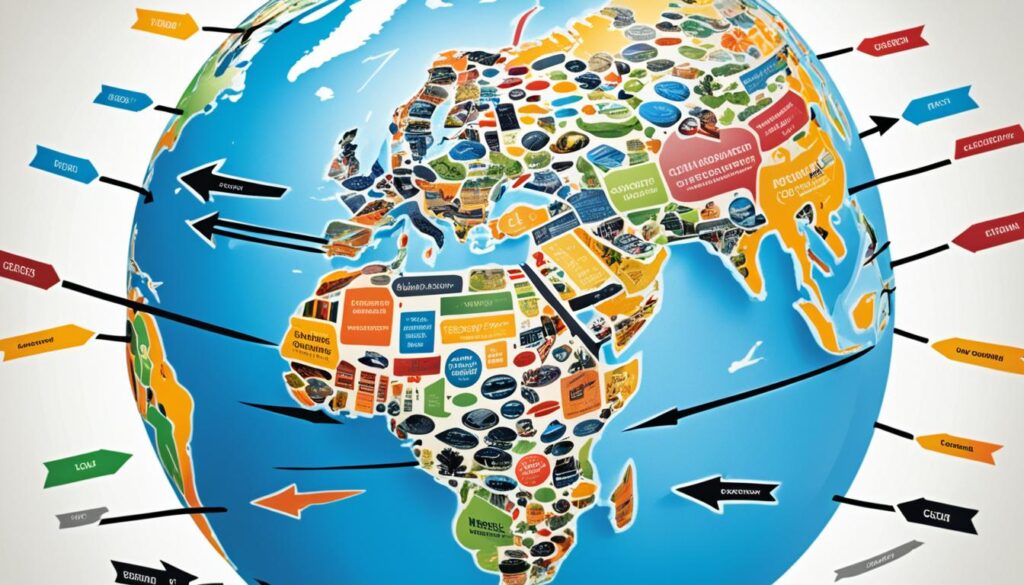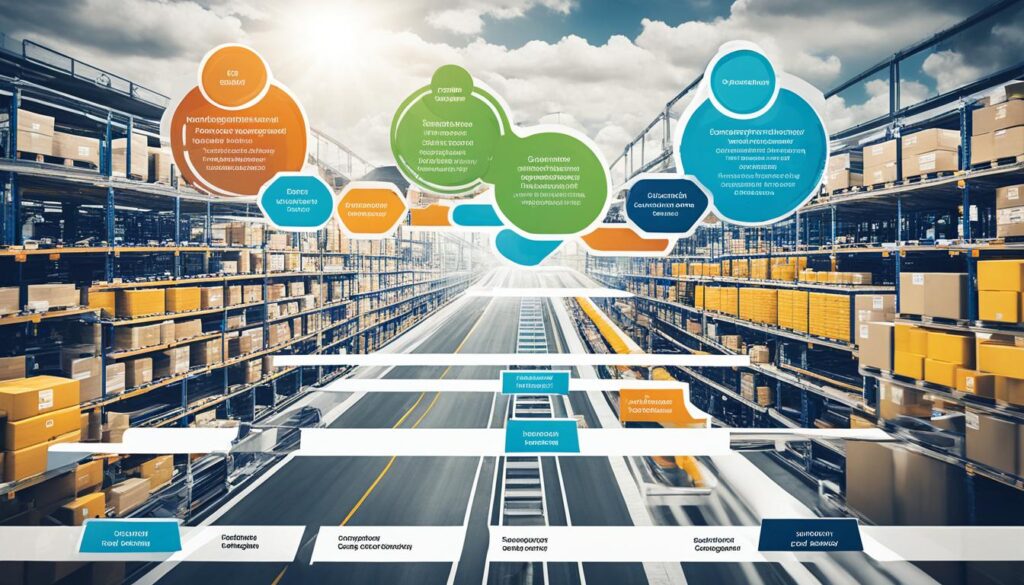In an increasingly interconnected world, the realm of international trade law has become a labyrinth of global regulations, agreements, and disputes. As businesses strive to navigate this complex landscape, they face a myriad of challenges and risks. How can organizations effectively maneuver through the intricate web of cross-border commerce laws, import-export frameworks, and ever-evolving trade policies? And what strategies can help them ensure compliance while maximizing opportunities?
Key Takeaways
- Global trade regulations pose significant challenges for businesses, including inconsistent regulations, a dynamic regulatory environment, documentation burdens, and language barriers.
- Automation and technology, collaboration and knowledge sharing, education and training, centralized data management, and agile supply chain design are effective strategies to overcome trade law complexities.
- Economic uncertainty, digitalization and e-commerce, scaling and sustainability, labor and logistics, compliance and regulatory hurdles, and multi-level governmental apparatuses are additional critical aspects of international trade law.
- Staying informed, proactive, and adaptable is essential for successful navigation of the international trade law landscape.
Challenges Posed by Complex Global Trade Regulations
The complexity of global trade regulations presents a multitude of challenges for businesses navigating the international marketplace. These challenges include:
- Inconsistent regulations: Trade regulations, tariffs, and customs procedures vary across different countries, creating compliance obstacles and complexities for businesses operating in multiple jurisdictions.
- Dynamic nature: Trade regulations are influenced by political shifts, trade agreements, and economic conditions, leading to frequent updates and changes. This dynamic nature can catch businesses off-guard, requiring them to constantly stay informed and adapt.
- Documentation burden: Compliance with trade regulations demands meticulous documentation, with even minor errors or omissions potentially resulting in delays, fines, or seizures of goods. The burden of maintaining accurate and complete paperwork adds administrative challenges to the international trade process.
- Regulatory language barriers: The legal jargon used in trade regulations can create language barriers for businesses operating in non-native countries. The complex vocabulary and terminology present challenges for understanding and complying with the regulations.
- Risk of non-compliance: Failing to comply with global trade regulations carries substantial risks for businesses. These risks include financial penalties, rejections of shipments, and damage to the company’s reputation. Non-compliance can lead to legal consequences and hinder future trade opportunities.
Effectively managing and addressing these challenges is crucial for businesses operating in the global marketplace. The next section will explore solutions to overcome these obstacles and thrive in the ever-evolving landscape of global trade.
Solutions to Overcome these Challenges
To address the complex global trade regulations, businesses can implement a range of effective solutions. Leveraging automation and technology is key, particularly through the adoption of trade management software. This software enables businesses to monitor and adapt to changing regulations, reducing the risk of human errors and ensuring compliance.
Data analytics plays a crucial role in predicting regulatory changes and evaluating their impact on supply chains. By harnessing the power of data, businesses can develop agile strategies that proactively address evolving trade regulations.
Collaboration and knowledge sharing are essential in navigating the complexities of global trade regulations. Businesses can benefit from participating in industry networks and forging partnerships with experts such as customs brokers and legal consultants. These collaborative efforts provide valuable insights, guidance, and in-depth knowledge on trade regulations and compliance.
Education and training programs are instrumental in equipping employees involved in supply chain management with the necessary knowledge and skills. Internal training programs and external workshops can enhance understanding of trade regulations, compliance procedures, and documentation requirements. By investing in education and training, businesses can ensure that their workforce is well-equipped to tackle the challenges of global trade regulations.
Centralized data management is essential for seamless compliance with trade regulations. By establishing a unified platform for data management, businesses can streamline operations and facilitate easy access to information, making compliance processes more efficient.
Real-time tracking technologies enable businesses to monitor shipments and ensure compliance throughout the supply chain. With real-time visibility, businesses can identify any potential compliance issues promptly and take necessary actions to mitigate risks.
Achieving an agile supply chain design is crucial in navigating global trade regulations. This involves diversifying sourcing strategies and embracing local sourcing to minimize the impact of international regulations. By diversifying suppliers and incorporating local sourcing, businesses can foster resilience and adaptability in the face of regulatory changes.

By implementing these solutions, businesses can effectively overcome the challenges posed by complex global trade regulations. Automation, collaboration, education, and agile supply chain design enable businesses to navigate the regulatory landscape with confidence and ensure sustained compliance.
Economic Uncertainty and Debt in Global Trade
Economic uncertainty, debt, and their impact on global trade
When it comes to global trade, economic uncertainty and debt pose significant challenges. To navigate these complexities, government affairs professionals must closely monitor fiscal policies, government spending, and debt levels. Understanding the influence of these factors on trade regulations and policies is crucial for businesses operating in an ever-changing global marketplace.
One of the key drivers of economic uncertainty is the fluctuation of currency exchange rates. These fluctuations can have a profound impact on global trade dynamics, influencing pricing, profitability, and competitiveness in different markets. Close monitoring of currency trends is essential for businesses to make informed decisions and mitigate potential risks.
Additionally, the level of debt in a country can significantly affect trade regulations and policies. High levels of government debt may result in stricter trade regulations or the implementation of protectionist measures. By staying informed about debt levels and their implications, businesses can adapt their strategies and anticipate potential trade barriers.
“Understanding the complexities of economic uncertainty and debt is essential for businesses engaged in global trade. By closely monitoring fiscal policies, government spending, and currency fluctuations, companies can make informed decisions and navigate the ever-changing global marketplace effectively.”
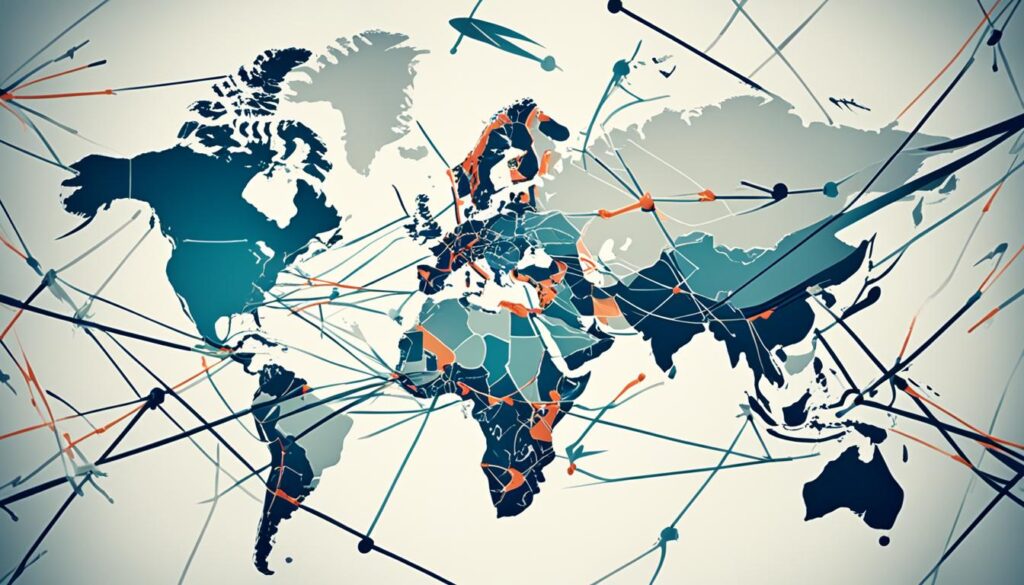
| Challenges | Implications |
|---|---|
| Economic uncertainty | Uncertain market conditions, pricing fluctuations, and investment hesitation |
| High debt levels | Possible trade barriers, protectionist measures, and policy changes |
| Currency fluctuations | Impact on pricing, profitability, and competitiveness in different markets |
It is crucial for businesses to stay abreast of economic indicators, fiscal policies, and government spending to anticipate potential shifts in trade regulations. By actively monitoring economic uncertainty and debt levels, businesses can respond effectively to changing market conditions, capitalize on opportunities, and minimize risks.
Digitalization and E-commerce in Global Trade
The increasing digitalization of commerce and the rise of e-commerce are transforming the landscape of global trade. As businesses embrace digital capabilities, they unlock new opportunities for growth and expansion. However, this digital transformation also brings forth challenges that organizations must navigate to stay competitive and compliant in an evolving global marketplace.
The Impact of Digitalization on Global Trade
Digitalization has revolutionized the way businesses conduct international transactions. Through e-commerce platforms and marketplaces, companies can now reach global customers with ease, breaking down traditional barriers to cross-border trade. This has led to an exponential growth in online sales, enabling businesses of all sizes to access new markets and increase their customer base.
Moreover, digitalization has enhanced operational efficiency in global trade. Automation and data analytics tools enable real-time tracking of shipments, streamlined documentation, and optimized inventory management. These technological advancements have not only improved supply chain visibility but have also accelerated the speed of transactions, reducing lead times and enabling businesses to respond to customer demands more rapidly.
Regulatory Frameworks and Compliance Challenges
However, alongside these opportunities, digitalization has introduced new regulatory frameworks that organizations must navigate to ensure compliance. As e-commerce transcends national boundaries, governments are adapting their legal frameworks to address the unique challenges posed by digital trade.
Regulatory frameworks vary from country to country, covering areas such as data privacy, consumer protection, intellectual property rights, and cybersecurity. Businesses operating in the global marketplace must familiarize themselves with these regulations and implement robust compliance processes to protect their customers’ data and uphold the trust of their global partners.
Trends in Data Privacy and Cybersecurity
Data privacy and cybersecurity have become paramount concerns in global trade. With the increasing exchange of sensitive information across borders, organizations must prioritize the protection of customer data and intellectual property.
Emerging trends in data privacy regulations, such as the European Union’s General Data Protection Regulation (GDPR) and California’s Consumer Privacy Act (CCPA), are shaping the global landscape. Organizations must ensure they have appropriate measures in place to safeguard personal data and comply with these regulations when conducting international business.
Cybersecurity threats also pose significant risks to businesses engaged in digital trade. As technology advances, so do the sophistication and frequency of cyber attacks. Organizations must invest in robust cybersecurity measures, including encryption, multi-factor authentication, and employee training, to mitigate these risks and protect their digital assets.
Achieving Success in the Digital Era of Global Trade
To succeed in the digital era of global trade, organizations must adopt a proactive approach. This involves ongoing monitoring of regulatory developments, partnering with experts in data privacy and cybersecurity, and prioritizing the implementation of best practices.
Companies should conduct regular risk assessments to identify vulnerabilities and develop strategies to mitigate potential threats. Collaborating with government bodies, industry associations, and other stakeholders can also provide valuable insights and help shape regulatory frameworks that support a secure and fair digital trading environment.
The benefits of digitalization and e-commerce in global trade are vast, but they come hand in hand with evolving challenges. By embracing digital advancements and prioritizing compliance with regulatory frameworks, organizations can unlock new opportunities for growth and maintain a competitive edge in the global marketplace.

Scaling and Sustainability in Global Trade
As organizations venture into global trade, scaling their operations and expanding into new markets becomes imperative for growth and profitability. However, this pursuit of expansion should be balanced with sustainability concerns.
Scaling in global trade involves increasing the volume and reach of trade activities. It requires careful planning, strategic decision-making, and effective execution to enter new markets, develop distribution networks, and optimize supply chains. Scaling enables organizations to tap into new customer bases, leverage economies of scale, and drive revenue growth.
However, scaling must also consider the environmental impact of increased trade activities. As global trade grows, it necessitates the movement of goods across longer distances, leading to higher carbon emissions and ecological footprints. Organizations need to address these environmental concerns through sustainable practices and initiatives.
Sustainability in global trade refers to incorporating environmental, social, and ethical considerations into business operations. It involves adopting eco-friendly practices, reducing greenhouse gas emissions, minimizing waste generation, conserving natural resources, and promoting responsible sourcing.
Social responsibility and ethical practices are also essential aspects of sustainability in global trade. Organizations must ensure fair labor practices, promote diversity and inclusion, and avoid engagement in exploitative or unethical activities. This includes respecting human rights, adhering to labor laws, and upholding ethical standards throughout the supply chain.
By considering sustainability alongside scaling in global trade, organizations can foster long-term success and contribute to a more sustainable future. Embracing sustainable practices not only helps mitigate the environmental impact of trade but also enhances brand reputation, attracts socially conscious consumers, and builds stronger relationships with stakeholders.
To illustrate the significance of scaling and sustainability in global trade, we can refer to the following example of a multinational corporation:
“Company XYZ, a leading player in the global consumer goods industry, embarked on an ambitious expansion strategy to penetrate new international markets. To achieve this, the company invested in infrastructure development, established strategic partnerships, and optimized its supply chain network. However, in line with its commitment to sustainability, Company XYZ also implemented measures to reduce its carbon footprint. It adopted eco-friendly packaging materials, optimized logistics routes to minimize transportation emissions, and engaged in reforestation initiatives. By prioritizing scaling and sustainability in its global trade operations, Company XYZ has not only achieved impressive revenue growth but has also enhanced its brand image and demonstrated its commitment to environmental and social responsibility.”

In conclusion, as organizations navigate the complexities of global trade, scaling their operations while considering sustainability is crucial. By integrating environmentally-friendly practices, promoting social responsibility, and embracing ethical conduct, organizations can achieve growth and profitability while contributing to a more sustainable future.
Labor and Logistics in Global Trade
Labor shortages, workforce dynamics, and logistical challenges can significantly impact global trade operations. Therefore, it is crucial for businesses to stay informed about labor market trends, immigration policies, and logistics infrastructure to ensure smooth trade flows and commerce.
The labor market plays a critical role in global trade. Labor shortages in key industries can create bottlenecks and disrupt supply chains, affecting the timely delivery of goods and services. By understanding labor market trends, businesses can anticipate and address workforce challenges proactively.
Workforce dynamics, such as shifting demographics and evolving skill requirements, also influence global trade operations. Demographic changes, including aging populations and changing migration patterns, can impact labor availability and contribute to talent gaps. Keeping abreast of these dynamics enables companies to adapt their strategies and find innovative solutions to overcome labor-related obstacles.
Logistical challenges further compound the complexities of global trade. Efficient transportation, warehousing, and distribution networks are essential for smooth trade operations. However, inadequate logistics infrastructure or congestion at ports and checkpoints can lead to delays, higher costs, and overall trade inefficiencies.
Addressing these challenges requires proactive measures. Collaborating with industry stakeholders and government authorities to advocate for improved logistics infrastructure is crucial. Furthermore, leveraging technology and data analytics can optimize supply chain operations, enhance visibility, and mitigate logistical challenges.
Companies must also stay informed about immigration policies and regulations in key markets. Changes in immigration policies can impact workforce availability and require businesses to adjust their hiring and talent management strategies accordingly.
By closely monitoring labor market trends, understanding workforce dynamics, addressing logistical challenges, and adapting to immigration policies, businesses can position themselves for success in the ever-evolving landscape of global trade.
Key Takeaways:
- Labor shortages and workforce dynamics can disrupt global trade operations.
- Monitoring labor market trends and adapting to changing demographics is essential.
- Logistical challenges, such as inadequate infrastructure, can cause trade inefficiencies.
- Collaboration, technology, and data analytics can address logistical challenges.
- Understanding immigration policies is crucial for managing workforce availability.
Stay informed about labor market trends, tackle logistical challenges, and navigate immigration policies to ensure the smooth flow of global trade operations.
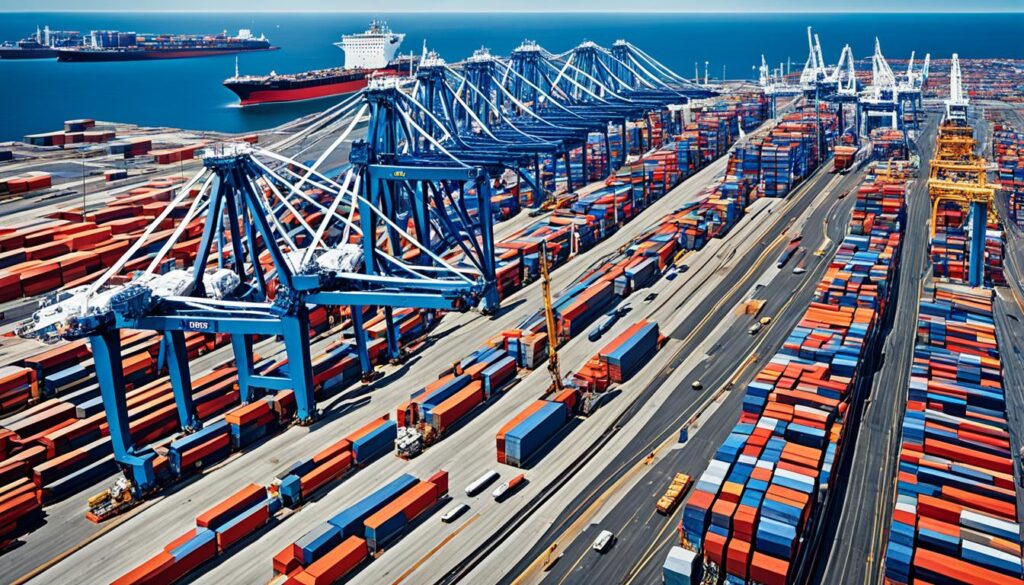
Compliance and Regulatory Hurdles in Global Trade
Navigating diverse regulatory regimes and ensuring compliance with ever-changing regulations are critical challenges faced by businesses engaged in global trade. With varying regulatory frameworks, trade agreements, and trade barriers across different regions, it is crucial for organizations to stay updated and adapt to ensure legal compliance and minimize associated risks. Failure to comply with regulatory requirements can result in severe consequences, including financial penalties, reputation damage, or even legal action.
Global trade involves conducting business across different countries, each with its own set of regulatory regimes and compliance requirements. From import-export regulations to customs procedures, businesses must navigate a complex landscape to ensure the smooth flow of goods and services across borders. Compliance with these regulations requires a comprehensive understanding of the specific requirements of each jurisdiction and the ability to adhere to them accurately.
Trade agreements play a significant role in shaping global trade regulations. These agreements establish frameworks for international commerce, facilitating the smooth movement of goods, services, and investments between countries. Understanding the terms and conditions of trade agreements is crucial to leverage their benefits and remain compliant with their provisions. Compliance challenges arise when trade agreements undergo revisions or when new agreements come into effect, requiring businesses to adapt their operations accordingly.
Trade barriers, such as tariffs, quotas, and import restrictions, further complicate global trade compliance. These barriers can significantly impact the flow of goods and services, affecting both importers and exporters. Businesses must carefully analyze and understand trade barriers within various markets to navigate compliance challenges effectively.
Minimizing Legal Risks through Effective Compliance Strategies
To minimize legal risks and ensure compliance with global trade regulations, businesses can adopt robust compliance strategies and best practices. Some key strategies include:
- Educating and training employees on trade regulations and compliance requirements.
- Establishing internal control procedures and processes to monitor and ensure compliance.
- Maintaining accurate documentation and records to demonstrate compliance.
- Implementing trade compliance software and technology to automate compliance checks.
- Engaging with trusted trade compliance experts and legal professionals to stay updated on regulatory changes and seek guidance as needed.
By implementing these strategies, businesses can navigate the complex compliance landscape of global trade, reduce legal risks, and maintain a strong reputation in the market.
| Key Challenges | Solutions |
|---|---|
| Inconsistent regulatory regimes across different jurisdictions. | Educating employees on regional regulations and establishing a centralized compliance management system. |
| Dynamism of trade regulations due to changing geopolitical dynamics. | Regularly monitoring changes in regulations and trade agreements, and swiftly adapting operations accordingly. |
| Documentation burden and complexity. | Implementing efficient record-keeping systems and leveraging trade compliance software to streamline documentation processes. |
| Language barriers and understanding complex legal jargon. | Engaging with legal experts and language professionals to aid in interpreting and understanding regulations. |
| Risk of non-compliance and associated legal consequences. | Investing in compliance training, internal audits, and conducting regular compliance risk assessments to mitigate potential risks. |
Multi-Level Governmental Apparatuses in Global Trade
Engaging in global trade requires organizations to navigate through multi-level governmental apparatuses, which include local, national, and international bodies. Understanding the decision-making processes, power dynamics, and stakeholders at each level is crucial for effectively advocating for an organization’s interests.
At the local level, businesses need to engage with municipal or county governments to address specific trade-related issues, such as obtaining necessary permits or licenses and ensuring compliance with local regulations. This interaction forms the foundation for businesses to operate within a specific jurisdiction and establishes their legal framework for global trade activities.
On a national level, businesses must understand the trade policies, regulations, and agencies that shape the overall trade landscape. This includes engaging with various governmental bodies such as trade ministries, customs departments, and industry-specific regulatory agencies. Collaborating with these stakeholders allows businesses to influence and shape trade policies that align with their interests and objectives.
At the international level, organizations must navigate through complex decision-making processes influenced by global entities like the World Trade Organization (WTO), regional trade blocs, and international agreements. This involves active participation in trade negotiations, compliance with international trade laws, and advocating for policies that foster fair and open global trade. Understanding the power dynamics within these organizations is essential to effectively represent an organization’s interests and contribute to shaping the global trade landscape.


